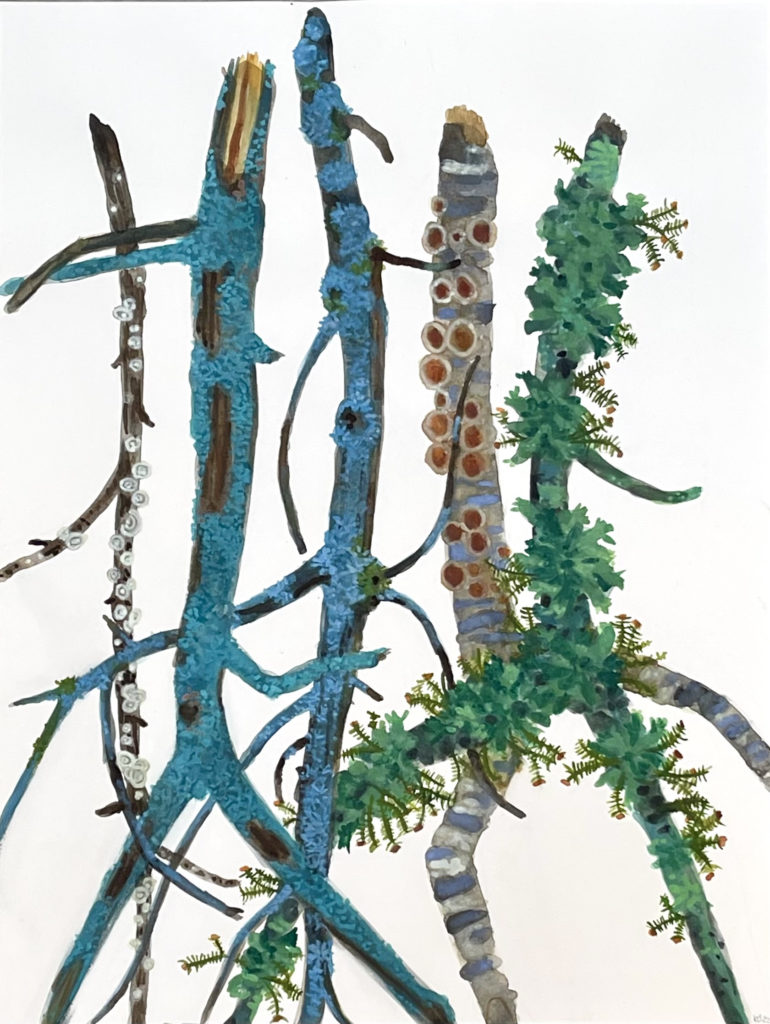The Brooklyn Rail | By Robert R. Shane | May 2021
It’s not always a bad thing if you can’t see the forest for the trees. Katie DeGroot’s seven life-sized watercolor tree trunk paintings collectively appear as a forest when first entering her exhibition Boscage, but as we get lost in the details of each scene the trees quickly take on relatable human characteristics, such as the comically crowded line of trees in The Procession (Ara Pacis) (2021), the nuclear family drama of two large trunks ensnared in the flailing branches of the saplings flanking them in Needy (2020), or the droopy birch awkwardly squeezed between two colorful cliques of deciduous revelers adorned in stoles of moss and fungi in Cocktail Party VII (2020).
The shallow stage for these scenes, set against bare white paper backgrounds, brings the viewer close to these narratives and invites them to explore DeGroot’s resplendent textures and patterns built with glistening glass-like layers of watercolor. Vulnerable, bombastic, and at times mournful—they are felled trees after all—the trunks and branches in DeGroot’s comedy of manners invite us to look closer at them and ourselves.

We are led into the exhibition by The Procession (Ara Pacis), a parody of the outer reliefs from the open-air altar celebrating Caesar Augustus’s military conquests. In DeGroot’s interpretation, 15 trees crowd together, their bowing trunks and spindly branches break with the regimentation of their queue. DeGroot’s painting reminds us that the packed processional scenes of guards, priests, royal family members, and their attendants carved into the painting’s ostensibly solemn first century BCE Roman counterpart, were always a bit hectic if not comical: young children pop forward in high relief while tugging impatiently at the togas of adults, and adult imperial family members turn their heads around against the flow of traffic to converse with each other. This blurring of the classical and the comical recalls one of DeGroot’s major influences: the Hairy Who painter Gladys Nilsson who has called comedy a high art form.

The ambitious group scenes like The Procession (Ara Pacis) in this exhibition have grown out of DeGroot’s earlier series, started in 2010, of singular “portraits” or duets—and an occasional trio—painted from fallen branches that she brings back to her studio after her hikes in upstate New York. She chooses each for the personality it exhibits to her in the wild, and the cast she develops recurs from painting to painting. The exasperated epiphytic fern-covered parent in Needy, for example, is also a member of a multicolored chorus in Resplendent (2020), in which a bundle of trees swell, contract, then thrust upward.

In every piece DeGroot’s mesmerizing detail calls for the viewer to look closer. In Cocktail Party VII, orange fungi encircled in yellow ochre cling to a blue tree that snuggles with another trunk rendered in a blizzard of white dashes. Small clusters of spritely, sharp needles sprout on one balsam fir whose trunk is built up with horizontal blue dabs recalling the boldness and elegance of Vermeer. A paper birch’s peeling bark flaps and waves, pointing us elsewhere, while deep fissures in maple bark trap us in their shadows. This careful attention to detail bestows a monumentality on these trees, even those in humorous situations.
Read the full article at The Brooklyn Rail >